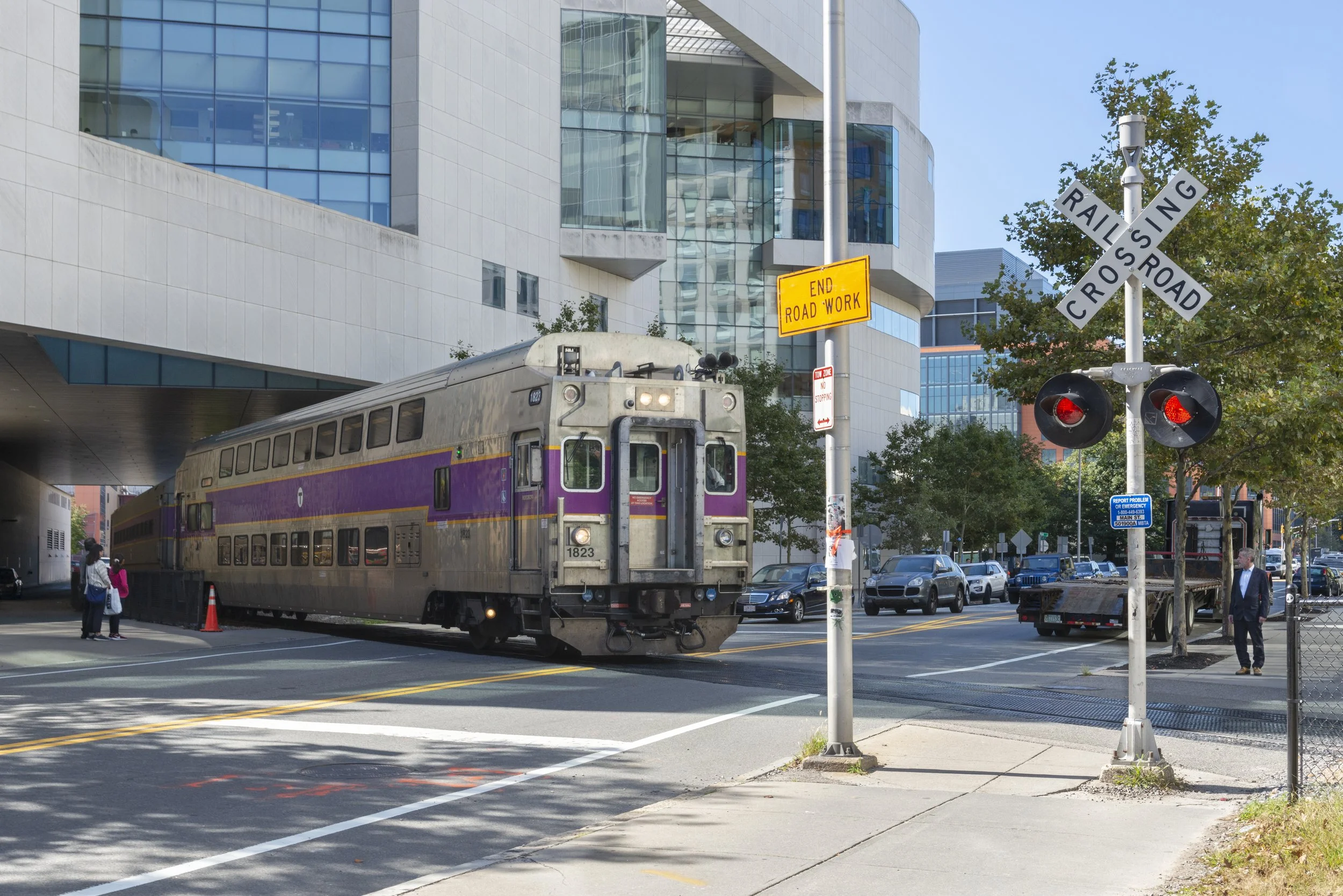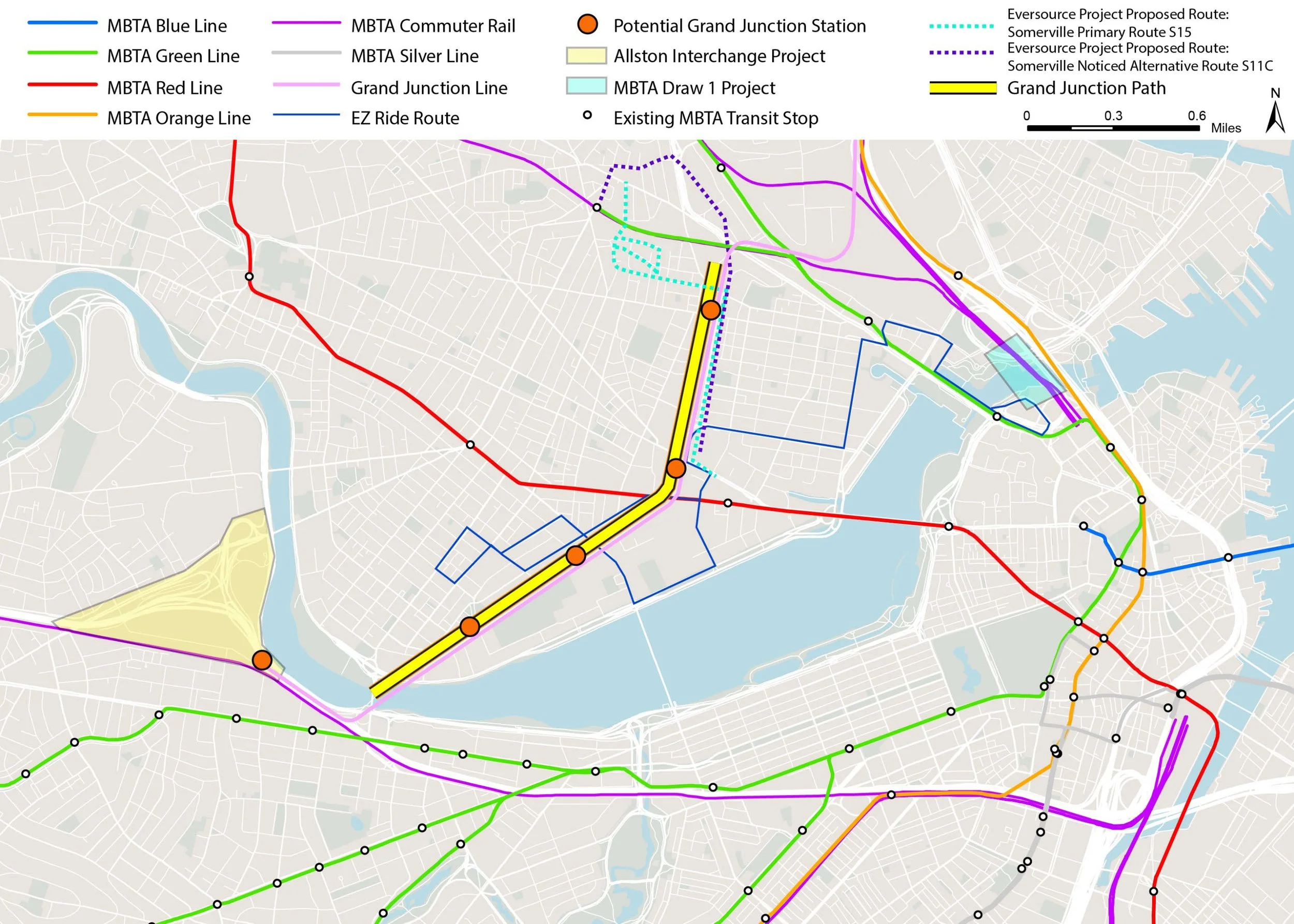
Grand Junction Transit Feasibility Study
This engineering feasibility study was conducted by WSP on behalf of the CRA as part of developer BXP's efforts to mitigate the ongoing MXD development project in Kendall Square. This study reflects one of the main priorities of Transport Kendall, a guide created by the Kendall Square Mobility Task Force to determine transportation investments supporting the district's continued development.
About the study
The Grand Junction Transit Feasibility Study provides a review of existing conditions and previously published studies, identifies feasible vehicle technology and frequency options for future commercial service, and outlines a conceptual two-tracked rail alignment compatible with the future multi-use path along the corridor. The study also identifies conceptual station locations for future service within the City of Cambridge, and concludes with a summary of operational alternatives with approximate “order of magnitude” costs for each option.
The study also explores ridership projections and travel times, and found that transit service between North Station and future West Station would not only attract a substantial amount of existing ridership, but attract a great deal more travelers with the future growth planned in Kendall Square and Allston. This service would offer time savings for numerous existing commuters and also provide a vital cross-system connection within Boston's largely radial rapid transit network.
Key study findings for future grand junction transit service
-
The study determined Urban Rail as the most feasible transit mode. This determination was based on certain core assumptions, such as the need to retain existing commuter rail, Amtrak, and freight movements on the corridor. The study team selected electric propulsion vehicles out of a desire to avoid the use of fossil fuels, with either Electric Multiple Unit (EMU) or Battery-EMU (B-EMU) trainsets as potential equipment options.
Other benefits of Urban Rail:
Looks and feels like Light Rail (similar to the Green Line), but operates on commuter rail tracks
Shorter train length (2-4 cars, versus 8+ seen on commuter rail) for better fit in urban setting
Relatively lower noise and vibration
Compliant with FRA restrictions which exist on the corridor
-
The study assesses the potential of new passenger service operating along two alignments:
Core Route between the future West Station and North Station, passing through Kendall Square
Extended Route linking communities further north (Everett, Chelsea, Revere and Lynn) with a future West Station via the Grand Junction
Proposed alternatives vary service frequency along the Core Route, with trains:
every 15 minutes (option “a”), or
every 17.5 minutes (option “b”)
The Extended Route showed strong ridership potential but was not recommended as it would interfere with future commuter rail service plans operating at 15-minute frequencies. A 20-minute service frequency was explored as well, but ultimately did not provide significant time savings to warrant further study.
-
There is significant ridership potential for a new passenger service along the Grand Junction based on the sheer volume of existing transit users whose commute times could potentially be improved.
Perceived travel time takes into account out-of-vehicle travel time components (e.g., walk time, line transfer time) to get a more accurate estimate of a rider's full travel time between destinations. A Grand Junction service introduced at either a 15- or a 17.5-minute frequency would provide faster perceived travel times between Kendall Square and places like Worcester, Allston/Brighton, and the North Shore, compared to current options.
VIEW COMMUTER TABLES > -
Initial base year daily ridership estimates for a core Grand Junction service between North Station and West Station are assumed from existing transit commute markets, new ridership attracted from other modes by perceived reduced travel times, and intra-Cambridge ridership.
These initial base year daily ridership estimates are anticipated to fall between:
5,800 – 9,800 daily boardings
When projected out to a 2040 horizon year, daily ridership would range between:
6,500 – 11,200 daily boardings
This proposed core service, operating at either 15- or 17.5-minute frequencies, assumes four Cambridge stations located in between terminals at North Station and West Station.
It should be recognized that this modeling effort uses estimates that almost wholly focus on commute trips, as opposed to discretionary activities (e.g., all trips not related to work duties). Nevertheless, the projections demonstrate that there is ample ridership potential based on the amount of transit commutes centered around eastern Cambridge from other parts of the Boston area that could benefit from a Grand Junction service.
-
There is enough space currently existing along nearly the entire Grand Junction Railroad right-of-way (ROW) in Cambridge to accommodate two-tracks for passenger rail service. Two minor exceptions would require additional slivers of right-of-way (1.5 and 3 feet, respectively) to provide the necessary clearance. These occur at two pinch points as the track alignment transitions horizontally across two streets. As analyzed in this Study, double-tracked passenger rail service can co-exist with the multiuse path planned by the City of Cambridge within the Grand Junction ROW. There is enough ROW space to safely accommodate both projects.
The study identifies a number of infrastructure improvements as necessary to operate effective passenger service on the Grand Junction, including:
Double tracking
Renewal of the track structure
Providing direct track connections to the Fitchburg and Worcester Lines
Bridge improvements crossing the Charles River
Train signal (including mandatory positive train control, or PTC)
Traction power (if electric- or battery electric-powered vehicles are used)
Grade crossing upgrades including interconnections with adjacent traffic signal systems
Possible mitigation measures to address noise and vibration, preclude public access, and address potential safety concerns
-
In most previous studies, a single Kendall Square station has been assumed within the vicinity of grade crossings at Main and Binney Streets. This study assumes that the corridor would be double-tracked to provide a continuous two-track alignment from Memorial Drive to the Fitchburg Rail Line. Such a change would allow for the creation of multiple stations within the City of Cambridge.
The study assesses thirteen potential platform sites at five general station locations, and identifies preferred station sites at each:
Cambridgeport – Fort Washington Park
Massachusetts Avenue – north side of intersection
Kendall Square – north side of Broadway
Eastern Cambridge – south of Medford Street/Gore Street (within City of Cambridge)
Cambridge Crossing – Water Street (within City of Somerville)
The study team accounted for multiple factors in assessing potential platform sites, including:
Mode and technology
Station area context
Ease of implementation and potential conflicts
Since a platform serving Cambridge Crossing would be located beyond the City of Cambridge (i.e., City of Somerville) and would only be serviced by one of the two routes considered (i.e., only by trains operating to/from North Station via the Core Route), this location was not considered within travel time modeling.
-
Two sets of estimates were prepared for both a Core Route and Extended Route option, with each option generating a cost estimate that assumes full electrification and another that relies on battery-electric propulsion (i.e., assuming the line is not electrified). The estimates reflect the capital costs associated with infrastructure improvements along each route, and include conceptual costs for procuring dedicated trainsets for the new service.
The conceptual cost estimates are based on a number of conditions and assumptions; for a full understanding of the conceptual costs, please see Section 5.5 in the full report.
-
Further study will be necessary to bring a Grand Junction transit service from idea to plan. Areas of top consideration include:
Safety at Grade Crossings: safety for all road users is paramount, and the Grand Junction's crossings with Cambridge streets require significant study. The rail track crosses a number of MBTA bus routes, including the popular Route 1 bus. Consideration of traffic impacts and further development of safety measures for bicycle and pedestrian traffic will be necessary as part of any future planning for transit on the corridor.
Capacity at North Station: while this study assumed dedicated platforms available for use at North Station, capacity for this service to alight at North Station may be limited depending on the final scope of the Draw One Bridge Replacement Project. Further study and discussion of alternatives will be needed.
Future West Station: this study assumed a future West Station as the southern terminus of a Grand Junction service. As the project is still in planning stages, its development will continue to shape the overall feasibility of a future Grand Junction commercial transit service.
Charles River Southern Crossing: the Grand Junction railroad crossing at the Charles River underneath the BU Bridge is not included in the project scope for the Allston Multimodal Project, and the bridge is presently single-tracked. Further study and planning for this portion of the corridor will be necessary.
-
Study Consultant:
WSP
Funding Partners:
BXP
Year Started:
2022 -
Cecelia Cobb, ext 19, ccobb@cambridgeredevelopment.org
This Project In The News




